1
Robo rozzers
Visitors to Dubai’s busy shopping arcades may be surprised to find themselves under the protection of a humanoid police robot. Though it has no mouth, the expressionless bot communicates in Arabic and English, and helps tourists navigate the city, as well as connecting them directly with police services via a touchscreen.
Dubai’s answer to RoboCop dresses and salutes like a police officer but is actually from an existing family of robots known as REEM, built and programmed by the Barcelona-based company PAL Robotics.
“Citizens can use the robot to contact the Dubai police call centres, speaking through the integrated microphones, and accessing other police-related services such as paying traffic fines. The robot can also report any incidents to a command control centre,” a source at PAL tells us.
REEM robots had already spent a number of years working at public events, so it was just a case of customising its software to include police functions, PAL says. The police version has face recognition software, meaning it could potentially catch a criminal by making comparisons with the police database. PAL hopes that the robots will become more accepted as people get used to seeing them around, and we might see them filling roles in healthcare and hospitality in the not-so-distant future.
PAL would not confirm whether it had any further robots on order for Dubai police, or if it would be upgrading the current model. However, Saif Salem Juma Ali Alkaabi at the Dubai police told us that “the numbers of robots will increase for sure”. Its Smart Services department previously set a target of replacing a quarter of its on-patrol officers with robots by 2030. The Dubai government has also announced plans for a new model that makes the current officer look like little more than a glorified tourist information point. RoboCop 2.0 will, apparently, be able to run at 80km/h (50mph), controlled by an onboard human.
2
Self-drive surveillance
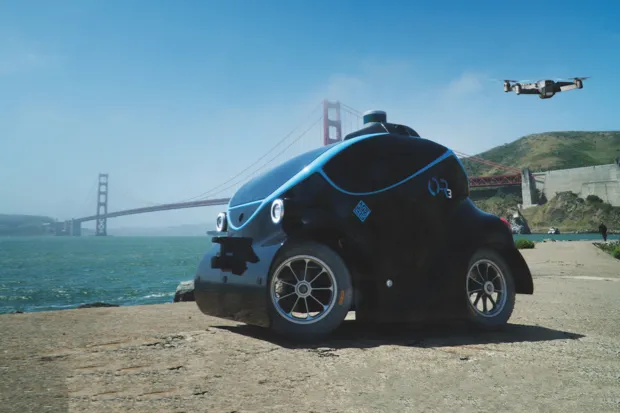
Dubai, it seems, is on a mission to dehumanise its police services. The city’s streets will also be patrolled by the OR-3 autonomous police car, the Dubai police force announced last year. At under a metre high, the OR-3 is too small to take a human passenger, but it doesn’t need one. The vehicle boasts a range of high-tech navigation and data collection tools: GPS, a laser scanner, thermal imaging and LIDAR – a remote-sensing method used in surveying. It’s designed for 360° surveillance and can track down police suspects using its biometric scanners. Oh, yeah, and who needs police helicopters? The OR-3 comes complete with a mini-drone that can be launched for aerial surveillance.
3
SWAT-bots
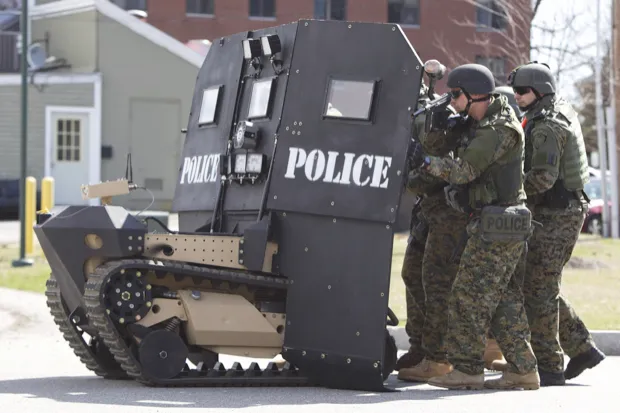
It looks like a tiny tank with a police shield attached, and that’s basically what it is. The ‘SWAT-Bot’ is designed to batter down doors and protect tactical teams of up to 12 people when approaching armed suspects. It can also be operated remotely.
Created by twin brothers, Mike and Geoff Howe of Howe and Howe Technologies, it was developed in conjunction with Massachusetts police, although so far there have been no reports of the SWAT-Bot being used for anything but drills.
4
The secret police
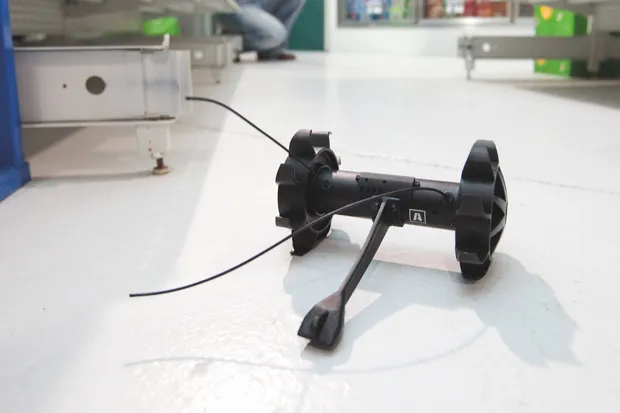
Another tool for tactical teams, the Throwbot XT is a miniature stealth robot that weighs little more than a rugby ball and can be thrown – literally – into any situation where a human counterpart might attract too much attention. Once in situ, it can be directed to quietly survey its surroundings, transmitting video and audio to an operator. Its makers, Minneapolis-based ReconRobotics, claim that the Throwbot can see in complete darkness and can be used to locate hostages and armed suspects.
5
Sharp Shooter
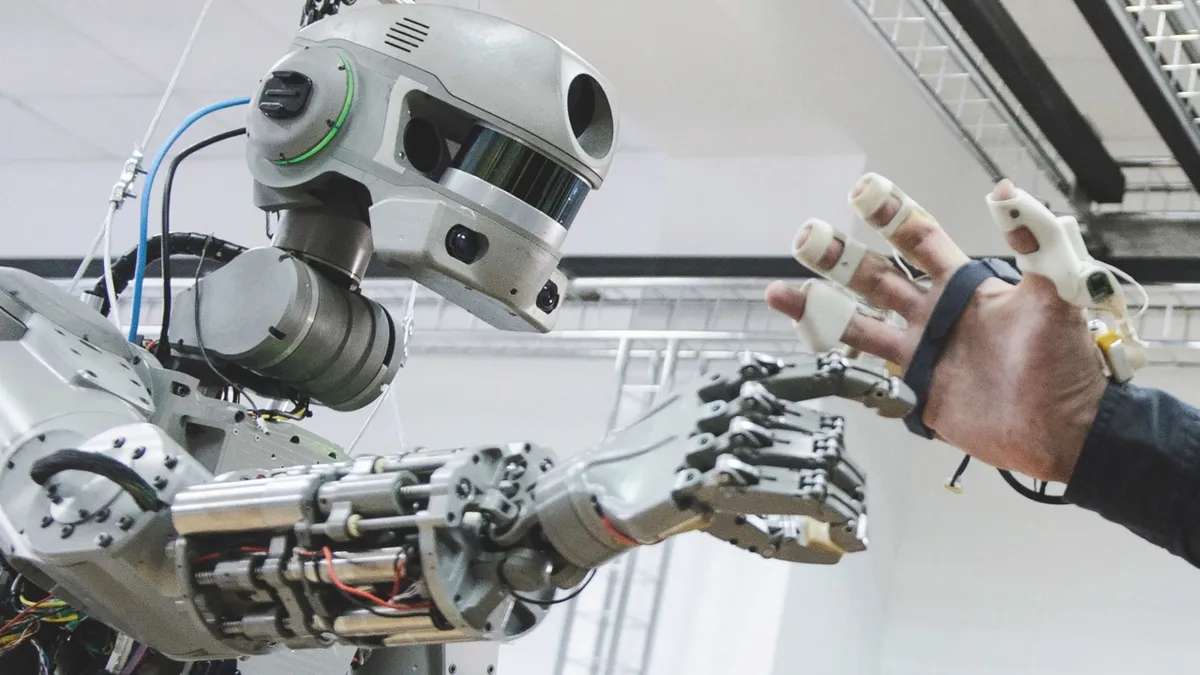
The Russian FEDOR is destined for the stars (okay, near-Earth orbit). The Russian space agency Roscosmos plans for the robot to pilot the unmanned Federatsiya spacecraft on its first mission in 2021. The bot’s fine motor skills give it the dexterity to screw in light bulbs and drive cars, but have also led to speculation about other potential roles. That’s because in April last year, FEDOR was filmed being trained to shoot two guns at once, firing double-handed like a gunslinger from the Wild West, and both on target.
While Russian officials were quick to point out that they are not “creating a Terminator”, some people have jumped to other conclusions. Meanwhile, scientists at Russia’s Advanced Research Fund, which built FEDOR in partnership with Android Technics, are also developing robots to assist special forces in the field. They are working on a prototype for a robot that will “deliver ammunition to the battlefield, support the sniper, and, if necessary, help in evacuation of the wounded,” the organisation’s deputy head of robotics, Alexei Kononov, told the Russian news agency RIA Novosti last October.
6
Bots on the beat
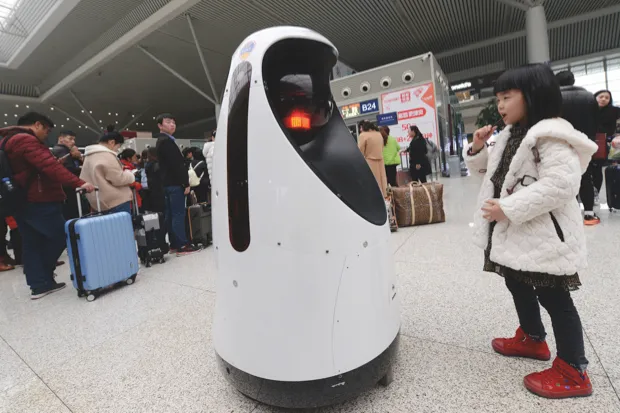
A railway station in Henan province, China, has its own RoboCop in the form of the E-Patrol Robot Sheriff (top image). Equipped with facial recognition software, it’s designed to identify and track criminals, and also functions as an environmental monitoring station thanks to its air quality and temperature sensors. These reportedly came in handy on the robot’s first day on the job, when it detected a fire.
Meanwhile, California has been trialling robotic security guards in shopping malls and car parks. The US-made Knightscope K5 (bottom image) works like CCTV, transmitting data to a control centre. Undeterred by a collision with a toddler and a self-‘drowning’ incident in a fountain, Knightscope recently unveiled K5’s shiny new successor, K7 – a three-metre-long buggy that can patrol on grass or sand.
This is an extract from issue 320 of BBC Focus magazine.
Subscribe and get the full article delivered to your door, or download the BBC Focus app to read it on your smartphone or tablet. Find out more
[This article was first published in April 2018]
Follow Science Focus onTwitter,Facebook, Instagramand Flipboard